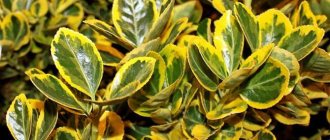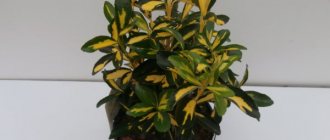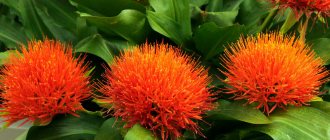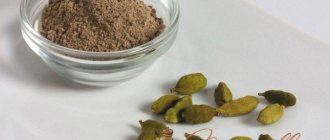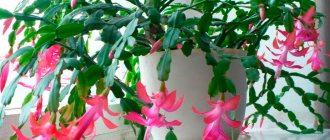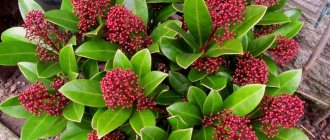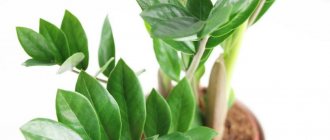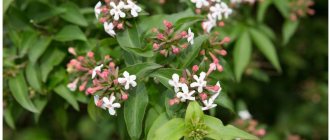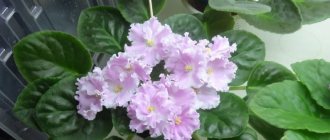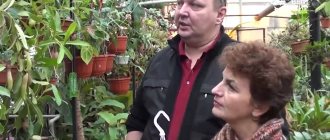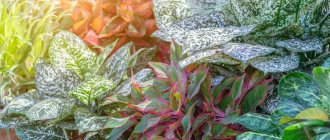The perennial evergreen dwarf plant nightshade (solanum) can be a wonderful decoration for any room if you know how to care for solanum. Growing in the form of a bush or small tree, it has luxurious decorative qualities - all year round there are white flowers, dark green round ovaries and bright red fruits on nightshade branches. The trunk of indoor nightshade is woody, the leaves are small and elongated.
Nightshade is native to the island of Madeira and South America. The plant is considered an annual, but experienced gardeners have learned to extend its life. Caring for indoor nightshade involves annual replanting, providing good lighting and regular watering. To form a luxurious, lush crown, pruning is necessary.
Interesting information about nightshade
Nightshade (Solanum) is a genus of evergreen trees, shrubs, subshrubs, perennial and annual herbs belonging to the Solanaceae family.
The genus Solanum belongs to more than one and a half thousand plant species, distributed in warm areas of acceptable climate around the world. That is why the plant with small orange fruits has many popular names. You can hear: solanum, potato tree, Jerusalem cherry, Cuban cherry, indoor cherry. The South African continent and some countries of Southeast Asia are considered the homeland of the predominant part of the Solanaceae genus.
What is nightshade? The external characteristics of nightshade are absolutely not similar to each other, if, for example, you compare the same dark-fruited nightshade with potatoes, tomatoes, eggplants, or a valuable medicinal flower - black nightshade. In natural conditions, these are small shrubs covered with greenery all year round. The leaves are oblong oval shaped. Inflorescences are racemose or paniculate. Nightshade flowers are white, yellow, purple or pink, collected in racemose or paniculate inflorescences. Bright orange fruits, reminiscent of cherries, give the plant a special charm.
A houseplant with red berries called nightshade (solanum) has become a very common decoration and addition to the interior of apartments, offices, and balconies. And in order for indoor cherry to feel at ease, it needs to create conditions close to natural ones. Namely, air humidity should be high, do not forget about spraying and coolness in winter.
What conditions are optimal for nightshade?
It should be remembered that decorative nightshade is a plant from the tropics, so the conditions should be as close to natural as possible. The plant requires constant spraying and maintaining an optimal temperature, which is lowered in the winter.
The flower is also quite light-loving, but categorically cannot tolerate direct sunlight.
If a flower doesn’t like something, it will notify you about it:
- dropping leaves means the plant lacks light
- scanty flowering and small fruits - about insufficient heat
- curling leaves - about excess sun rays
- drooping, limp leaves - about poor watering and a hot place
- shriveled berries - about a lack of moisture in the soil
- dull leaves - about lack of nutrition
The humidity level should always be high and not fall below 60%.
Characteristics of the nightshade family
Solanaceae is a family of plants that, as of 2022, has 115 genera and more than 2,700 species. People encounter many of them every day: indoor flowers, common vegetables, tobacco and medicinal plants.
Representatives of the nightshade family
Representatives are divided into three life forms:
- herbs;
- shrubs (erect and creeping);
- trees (nightshade or acnistus).
Together with the Convolvulaceae family, they form the general order of Solanaceae.
Application
In cooking
Young nightshade leaves can be added to salads, and black nightshade berries are widely used in cooking. The fruits can be eaten raw or made into jam, jelly, or used as a filling for pies and pies. The berries are also used as food coloring.
In medicine
Black nightshade is widely used in medicine. Various drugs are made from it to treat leukemia, asthma, inflammatory processes, eczema, rheumatism, and polyarthritis. Drops containing nightshade help with otitis media. Freshly squeezed berry juice is effective as a sleeping pill.
Nightshade is useful for the treatment of tuberculosis, sore throat, whooping cough, influenza, jaundice, various skin diseases - eczema, dermatitis, psoriasis, and kidneys. A powder is made from the stems of the plant, which is used to treat pancreatitis; it is taken orally before meals. A decoction is prepared from nightshade, which has beneficial properties for malignant blood diseases, asthma and skin diseases.
general information
False pepper nightshade is a perennial evergreen plant that belongs to the nightshade family. The stems branch and become woody over time; the plant can grow up to 50 cm in height.
The leaves are medium-sized, oblong, glossy, arranged in pairs and densely on the branches. The flowers are formed small, shaped like stars, the petals are painted white.
Photo of nightshade
After flowering, round fruits are formed that look like cherries. As they mature, their color changes from pale orange to red.
Preparation and storage
Black nightshade berries are collected from August to October; it is at this time that they are ripe and suitable for consumption. Nightshade herb for medicinal use must be collected while the plant is in flower. Fruits and herbs should be dried outdoors in the shade. Dried raw materials are transferred to wooden boxes; shelf life is up to 6 years.
Toxicity and medicinal properties of the flower
Many people are concerned about the question: is indoor nightshade poisonous or not? Unfortunately, all parts of the plant are poisonous. Experts do not recommend growing this plant in a house where there are small children.
When choosing a nightshade variety to keep in an apartment, you need to start from how you plan to use it. If for purely decorative purposes, take the false pepper variety.
He is poisonous, but very beautiful. For medicinal purposes, pepper nightshade is chosen. It is used in the treatment of sore throat, healing of cuts and minor wounds.
In homeopathy, the plant is used to combat skin diseases, relieve ear pain, and treat rheumatism and gout.
All nightshade medicines that you decide to prepare at home must be made in accordance with the exact dosage. It is advisable to consult a doctor.
What is the appeal of indoor nightshade?
As you already understood, a houseplant with orange berries is nightshade, or solanum. Belongs to the nightshade family. Its homeland is the tropical part of South America.
There are various rumors about him. Some flora lovers are afraid to keep it at home. It turns out that the bright berries for which the flower is valued have poisonous properties. The fruits should not be eaten. Be careful if there are small children in the house. Place the plant on high, inaccessible shelves and cabinets, or avoid the flower altogether.
Nightshade does not produce any toxic fumes. If he just stands indoors, he won't cause any harm.
Nightshade is a small evergreen shrub. The leaves are shiny, oblong in shape. The fruits are large, similar to cherries, and have a fiery orange color.
A houseplant with orange berries, a photo of which will prove its beauty, will, with proper care, delight you with its ovaries and flowers. All this creates a beautiful picture. Therefore, nightshade is an excellent room decoration and addition to the interior.
Homemade remedies from nightshade
- Herbal decoction: pour 1 teaspoon of dry raw material into 250 ml of water and keep in a water bath for 15 minutes, then cool and strain. Drink 1 teaspoon 2 times a day for 10 days for rheumatic pain, cystitis, gastritis, bronchial asthma, neuralgia, cough;
- Infusion of herbs and flowers: pour 1 teaspoon of crushed raw materials into 250 ml of boiling water and leave for 3 hours. Take the strained drug 1 tbsp. spoon 3-4 times a day for the treatment of neuroses, rheumatic, joint and headaches, can also be used as compresses for boils and lichen;
- Infusion of leaves: 8 tbsp. Infuse tablespoons of raw material in 2500 ml of boiling water for 4 hours. Use for sitz baths in the treatment of external hemorrhoids, as well as for the treatment of purulent wounds and skin rashes;
- Product based on the juice of ripe berries: 3 tbsp. Dilute spoons of juice in 100 ml of warm water, leave for ½ hour. Use as a rinse for sore throats and inflammation of the oral mucosa;
- Herbal ointment: mix the powdered herb with sunflower oil in a ratio of 1:4, the resulting product is used to lubricate boils, lichens, ulcers, and festering wounds.
The most popular varieties
The nightshade family has about 1,700 members. The most common types of solyanum are kept at home, as well as in gardens and greenhouses.
Types of nightshade
In nature, there are several hundred species of nightshade in the form of trees and shrubs, but in cultivated floriculture you can more often find two varieties:
S. pseudocapsicum (false pepper) is a shrub up to 120 cm tall with long lanceolate or oval leaves. The fruits can be either orange-red or yellow, the flowers are white, five-membered.
Nightshade (Solanum pseudocapsicum)
S. capsicastrum (pepper-shaped) - similar to the previous variety, but different in size. Can be grown both at home and in open ground in the garden.
Pepper nightshade (Solanum capsicastrum)
Curly , this nightshade species is an evergreen vine. The flowers are shaped like stars, the fruits are light yellow in color. It is unpretentious in maintenance and is often used to decorate gazebos and walls. Unlike many representatives of its species, it tolerates cold well. Therefore, it can be used on external facades.
Solyanum vendlana is a climbing evergreen shrub that can grow up to 6 m in height. There are small thorns on the branches. The leaves are long (up to 10 cm), dissected in shape. The lower foliage is larger (up to 25 cm). This species has very beautiful purple-lilac flowers in the shape of a bell.
Which type of nightshade to choose is a matter of taste. It is also worth considering the size of the flower. Large spreading representatives are suitable only for large houses.
Description and types of plants
Nightshade is called "solanum" in Latin. There are up to 1,500 species of it in nature. These are mainly evergreen shrubs, native to the tropics and subtropics. But most often they can be found in South America. Most of them are perennial, but there are also annual specimens.
The nightshade family is so diverse that it includes herbs, climbers, shrubs and trees. Stems can be erect or creeping. The shape of the leaves is different, but depends on the variety - it can be simple or pinnately dissected.
Mostly popular are dwarf species that grow to a height of no more than 30 cm. Nightshade is distinguished by its rich green foliage and bright berries. For its decorative qualities, it is popularly called winter cherry. The plant is easy to care for; some varieties in the wild are even weeds and quickly adapt to external conditions.
It blooms at different times of the year depending on the variety. Nightshade flowers can be white, yellow, pink or purple. They are collected in panicles, scutes or brushes. They produce fruits with seeds inside. At first, the berries with a diameter of 1-1.5 cm are green, then gradually turn red or orange. They look impressive against a dark green background. To keep the fruits longer on the berry bushes, the pot is placed in a cool room.
Nightshade berries are poisonous and can cause severe intestinal upset. Therefore, when grown for decorative purposes, the plant must be kept away from small children and animals.
Types of indoor nightshade are presented in the table.
| Name | Description | Photo |
| Jasmine | A climbing shrub reaching a height of 4 m. Undeciduous leaves of an elongated ovoid shape grow in the upper part of thin shoots. Length 7 cm, width 3 cm. Flowers are light blue, collected in inflorescences in the form of panicles. Bright red fruits with a diameter of 1.5 dm | |
| Giant | Six-meter climbing shrub. The dark green leaves are elongated, lanceolate in shape, reaching 25 cm in length. The shoots are thick, covered with small spines and whitish hairs. Flowers of a lilac hue hang from the corymbose inflorescence. The berries look like red and orange balls | |
| Wendlanda | Branched evergreen shrubs up to 4 m high. The shoots have small thorns. The leaves in the lower part are trilobed, dark green, 25 cm long, in the upper part they are elongated, elliptical in shape, 10 cm long. The flowers are purple, collected in corymbose inflorescences-panicles. The fruit is also bright purple in color | |
| False pepper | Non-deciduous subshrub up to half a meter high with branched shoots. Elongated dark green leaves are lanceolate. Ever-blooming. It blooms with small white flowers that grow singly. Bright red berries resemble cherries in shape and color | |
| Peppery (pepper) | Another name is Jerusalem cherry. A low-growing shrub, reaching a height of no more than half a meter, with bluish-green leaves, wavy along the edge, oval in shape. Their length varies - from 2 to 7 cm. The flowers are white and small. Red berries with a diameter of 1 cm. Transverse nightshade has several varieties that differ in the color of flowers and leaves | |
| Curly | Fast growing liana. The second name is Glasnevin. The flowers are purplish-blue in color, star-shaped, like potatoes, and collected in apical corymbose inflorescences. The fruits are pale yellow. Tolerates cold better than other varieties | |
| Zeafort | The bush has a decorative appearance. It grows to a height of 5-6 m. The leaves are slightly wavy, lanceolate in shape. The inflorescence is in the form of a panicle, it contains hanging flowers of a light purple hue. Red-orange ovoid berries |
Reproduction
There are two methods for propagating nightshade: seeds and cuttings. By the way, the size of the fruit depends on the method of reproduction. Cuttings require time to root and adapt; fruits appear on them after a long time and are not large in shape.
Indoor nightshade produces strong bushes from seeds, and its fruits delight with bright color and decent size. Let's consider both methods in more detail.
Seeds
You can buy ready-made seeds or get them yourself from mature plants that bear fruit. First, they need to be disinfected in a weak solution of potassium permanganate, dried and distributed over the surface of the soil, sprinkled with a small amount of wet sand on top.
Cover the container with seeds with film or glass. Before sprouts appear, the greenhouse is periodically ventilated and the soil is moistened.
The emergence of seedlings should be expected in 2–3 weeks. As soon as the sprouts have appeared safely, the shelter is removed and regular watering and loosening of the soil begin. After the sprouts have formed 2-3 strong and healthy leaves, they can be planted in separate pots.
Cuttings
Choose healthy and strong branches. They are cut to a length of 10–15 cm and immediately planted in a pot. The soil should consist of equal parts sand and peat. Then the cuttings are covered with a glass jar and placed in a warm place.
The roots sprout in 2–3 weeks. It's time to transfer them to stationary pots with soil in the form of a mixture of sand, humus and peat. As soon as the young bushes are transplanted, they pinch out the upper shoots.
Benefit
The benefits of black nightshade emerge from its composition, which includes numerous vitamins, carotene, ascorbic acid, and minerals. Green fruits contain a toxic substance that disappears when the berries are ripe. Nightshade is used for diseases of the nervous system, hypertension, rheumatism, and atherosclerosis. Ripe berries strengthen the immune system; they can even be given to children in the form of jam or baked goods.
Black nightshade has the ability to relieve inflammation, reduce temperature, and has an expectorant, diuretic and choleretic effect. Ripe berries help with sore throats, improve vision, and the juice of the berries is useful for a runny nose.
Simple rules for growing berry mosaics at home
It is not difficult to grow a crop on your windowsill. It thrives in a variety of soils. The main condition is that the soil must be loose. Often, fans of home crops grow indoor nightshade from seeds, carefully monitoring its development. The process begins in late May or early June.
The seeds are evenly placed in small containers filled with suitable soil. Then they are covered with a layer of sand about 1 cm and irrigated with a spray bottle. The containers are covered with plastic wrap and placed in a room where the temperature is not lower than 22°C. It should also have plenty of daylight. The first shoots will turn green on the surface of the earth in about 14 days. When they get stronger and there are 3 leaves on the shoots, the sprouts dive into other containers. After 30 days, the grown seedlings are transplanted again, but to a permanent habitat.
The last dive is carried out when the nightshade bushes grow to 15 cm in height.
When the plant takes root, you need to know the rules of how to prune nightshade and not harm it. The procedure is performed several times a year. At the end of February or beginning of March, all shoots of the crop are shortened by a third of the main length. It is best to do this when all the berries are ripening and when the foliage turns yellow.
To effectively form an indoor nightshade bush, additional pruning is carried out in April or early May. The procedure is repeated before the buds open. To increase the bushiness of the crop in the fall, new shoots are pinched to branches where there are no buds and fruit ovaries. As a result, a cute decorative decoration strewn with bright fruits will appear on the windowsill.
Lighting
Nightshade should be provided with as much light as possible. If it is deficient, it can shed not only buds, but also fruits and leaves. To obtain good fruiting, good lighting is necessary. In winter, it is advisable to illuminate nightshade artificially. If this is not possible, then place it on the most illuminated windowsill near a south-facing window. In winter, the sun's rays are not so burning, so they will not harm the plant. In summer, it is advisable to take nightshade out into the fresh air. There it will rest well, develop, and gain strength for winter flowering and fruiting.
Content temperature
In winter, the optimal temperature for keeping it is quite low and lies within +12-15 degrees. This is an additional reason to place it on the windowsill, where the air temperature is lower than elsewhere. High room temperature is the most common reason why nightshade leaves turn yellow and fall off in winter. In summer, the air temperature is not particularly important for this plant, especially if it is located outside. On average it lies within +18-25 degrees. The range, as you can see, is wide and small deviations from it are not critical.
Note. Indoor nightshade really does not like temperature changes and drafts.
Watering
During the growth, flowering and fruit formation stages, nightshade should be watered abundantly. Do not allow the soil to dry out. When the flower goes into retirement (autumn–winter), it is rarely watered.
Spraying
Indoor nightshade must be sprayed frequently. To do this, use pre-settled water at room temperature. Spraying is especially important when kept warm in winter. You can also place a small container of water near the plant to increase the humidity level.
Top dressing
In order for a plant to bloom profusely and bear fruit, it needs a large amount of nutrients. Feed the plant in the spring-summer period once every 2 weeks. For this purpose, complex fertilizer for flowering plants is used. In winter, you can not add fertilizers to the soil or feed it once every 4 weeks (you should use ½ of the recommended dose).
Trimming
It tolerates pruning well. And they do it after the nightshade stops bearing fruit, so that it does not lose its decorative effect. In the last weeks of winter, one can often observe yellowing and falling leaves. A procedure such as pruning significantly improves the condition of the plant. Be sure to shorten the main stem, as this will provoke the growth of side branches. You should also pinch their ends.
Transfer
It is recommended to replant in the first weeks of spring, before intensive growth begins. The soil should be loose and easily permeable to air. Do not forget about a good drainage layer, which may consist of expanded clay. It is needed so that excess liquid can freely leave the pot. First, the plant is cut back by approximately 1/3, and then planted in new soil.
This plant does not live very long. So, it soon grows out and loses its decorative effect. Therefore, some gardeners advise not to transplant nightshade, but to root a cutting taken from it.
Nightshade pot
A plastic or ceramic pot is suitable for growing indoor nightshade, as long as it has drainage holes in the bottom. Its size should be slightly larger than the root system of the plant. In a container that is too spacious, the soil may become acidic, which will lead to the death of the plant.
Priming
The soil for growing nightshade must be sufficiently nutritious and loose. It is made up of equal parts of turf soil, humus and sand. For growing, you can also use a universal substrate for industrially produced indoor plants.
At the bottom of the pot, be sure to arrange a drainage layer of expanded clay or river pebbles.
Pests and diseases
The most common nightshade pests are:
- whitefly . First, green larvae of this pest appear, which subsequently turn into small midges. Larvae and adults feed on nightshade sap. The plant begins to fade, its leaves turn yellow and fall off. To combat whiteflies, ready-made preparations for this pest are used. To completely destroy whiteflies, nightshade must be sprayed at least 3 times, with an interval of 3-4 days. Before each treatment, it is necessary to remove all damaged leaves;
- orange aphid . Colonies of these pests can be found on the underside of leaves. Like the whitefly, the orange aphid feeds on plant sap. As a result, the leaves turn yellow, curl and fall off, and the plant gradually dries out. A strong solution of laundry soap works well against orange aphids. The bush should be sprayed with it 2-3 times within one week.
Important! When working with soap solution, it is necessary to avoid getting it on the soil.
- red spider mite . This pest appears on nightshade when indoor air humidity is low. When infested by a mite, a thin cobweb with red dots appears on the stem and leaves. To get rid of spider mites, it is necessary to increase the general humidity in the room and regularly spray the plant with warm water. If these measures are not successful, then you should use acaricides. Instructions for use can be found on the packaging of the drug.
Fruiting
During flowering in the natural habitat, pollen is carried by even a slight wind. If it is not possible to keep the plant on the balcony or garden while the buds are blooming, you will need to pollinate it yourself to produce berries .
To do this, you need to take a regular painting brush with soft bristles and brush it over all the stamens with pollen. Attention! If you do not carry out this manipulation, then there is a chance that you will not get the berries or their quantity will be minimal.
Rest period
In winter, nightshade requires a period of rest. To do this, place the pot with the plant in a cool, well-lit place at the end of October. The optimal temperature for nightshade in winter is +13-15°. When kept warmer, the plant begins to suffer from spider mites and whiteflies.
Brief description of cultivation
- Bloom . It starts in February or March and ends in October.
- Illumination . Needs a lot of bright light, which should be diffused.
- Temperature regime . In the spring-summer period - from 18 to 26 degrees, and in winter - from 12 to 14 degrees.
- Watering . In April–September, the soil mixture is moistened when its top layer dries out. With the onset of autumn, the frequency and abundance of watering is reduced. And in winter, they just make sure that the earthen clod does not dry out.
- Air humidity . Should be high at any time of the year. To increase humidity, the pot with the bush is placed on a deep tray filled with wet expanded clay. On hot days, the plant is moistened with a spray bottle.
- Fertilizer . From the last days of spring until the beginning of autumn, nightshade is fed 2 or 3 times a month. To do this, use a complex mineral for flowering crops in liquid form.
- Rest period . Starts in October and ends in February.
- Trimming . In spring, after the fruits have ripened and the foliage begins to yellow.
- Transplant . It is carried out annually in spring immediately after pruning.
- Soil mixture . Sod and leaf soil, peat (1:1:1).
- Reproduction . Stem cuttings and seed method.
- Pests . Aphids, whiteflies and spider mites.
- Diseases . If humidity and air temperature are excessively high, the plant may shed its leaves prematurely.
Indoor nightshade: how to properly care for and replant
Winter and summer nightshade care
Caring for a nightshade indoor plant in the cold and warm seasons has its own distinctive features. Features of seasonal care spring-summer .
- Young seedlings are watered as the soil dries.
- During the growth period, fertilizing is not needed. It is enough to carefully loosen the soil along the edges of the flowerpot so as not to injure the roots.
- When a nightshade blooms, it needs help transferring pollen from one flower to another (to pollinate).
- Upon reaching the age of 4-5 years, the plant is transplanted into a substrate mixed with turf.
- With the onset of summer, the flower is taken out into the open air to a shaded place protected from drafts.
- Water abundantly, adding fertilizer to the soil at least once every 2 weeks with a mixture of useful substances for tomatoes. Liquid fertilizers such as “Ideal” or “Rainbow” also give a good effect.
- Spray the leaves twice a day - morning and evening.
Features of seasonal care autumn-winter.
- As cold weather approaches, reduce the intensity of fertilizing and watering (water once every 10 days with soft water without chlorine). Nightshade should be in a dormant period from October to February.
- The pot with solyanum is placed in a cool, illuminated place with high humidity.
- Ventilate the plant once a week.
- At the end of February, the cherries will begin to wake up. During this period, you need to increase watering and start spraying.
Contraindications
- Pregnancy and lactation;
- Childhood;
- Hypersensitivity to the plant.
The use of the herb is not recommended for hypotension, severe diseases of the liver and pancreas.
It should be borne in mind that all parts of nightshade (except for ripe berries) contain a poisonous alkaloid that is not destroyed by heat treatment. If the prescribed dosages are not observed, the following symptoms of poisoning may occur: weakness, nausea, vomiting, increased frequency of stools, abdominal pain, overexcitation, speech disorder, drowsiness, breathing problems, cough with copious sputum, cardiac dysfunction, convulsions, coma. If any of the listed symptoms are observed, it is necessary to perform gastric lavage and call an ambulance.
Before using plant preparations, it is recommended to consult your doctor, and during the treatment period strictly adhere to the prescribed dosage regimen.
Possible difficulties when growing indoor nightshade
There aren't very many of them. But the main difficulty is that sometimes the nightshade does not want to bear fruit or the fruiting is scanty. The reason for this is under-pollination of the plant. Most often, this happens to plants that are constantly in the room and do not have the opportunity to fully pollinate. In this case, nightshade needs help. Artificial pollination of nightshade is not difficult. It is enough to walk over the flowers of the plant with a soft brush, transferring pollen from flower to flower.
The leaves are falling
Perhaps the problem is lack of moisture. The problem is especially acute in hot weather. This can also happen with excessive watering, when the roots begin to rot.
The berries are falling
If nightshade fruits begin to fall at the wrong time, it lacks light and humidity. It is worth moving the pot to a place where there is more light and spraying it more often.
No ovaries
The reason is that pollination did not occur. You can do this yourself using a soft bristle brush. Flowers are naturally pollinated only in the open air.
Spider mite
This pest affects many indoor plants. Its appearance is determined by the formation of small cobwebs and dark spots on the foliage. The plant begins to gradually dry out. To eliminate the problem, the foliage is sprayed with chemicals (Decis, Phosbecid), alternating with a soap solution.
Diseases and pests
If you are faced with a problem such as yellowing and falling of solanum leaves, this indicates that you are keeping the plant in conditions of high temperature and low humidity. Move it to a cooler place and remember to mist regularly.
Insufficient air humidity can cause your pet to be attacked by whiteflies or spider mites . If this happens, remove all affected parts of the plant and treat it with insecticides.
Proper conditions for keeping nightshade and conscientious care for it will ensure your plant a long life. However, do not forget in any case that solanum berries pose a danger to human health when consumed.
